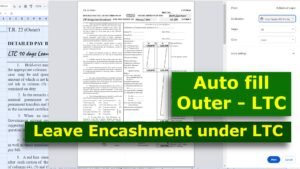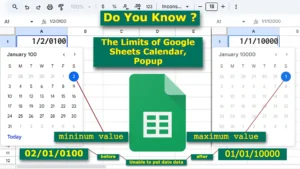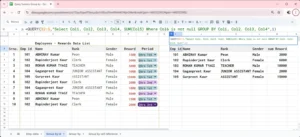
The Unified Pension Scheme (UPS), initially announced by the Central Government on August 24, 2024, has now been officially notified through a gazette notification on January 24, 2025.
It’s important to note that your monthly contribution under NPS is your own money, yet it is managed by the government with specific restrictions and conditions. This raises a fundamental question: Shouldn’t employees have the freedom to manage their own retirement funds?
However, the Government of India has introduced UPS as an optional scheme under the National Pension System (NPS) for Central Government employees, set to take effect on April 1, 2025.
NPS vs. UPS: A 12-Year Financial Comparison for Voluntary Retirees
A key distinction between the two schemes is the timing of pension benefits. Under UPS, pension payments begin only at age 60, making the total benefit dependent on lifespan post-retirement. In contrast, NPS offers financial support immediately after retirement, even if the amount is relatively lower.
However, this means NPS provides a 12-year financial advantage over UPS before age 60, ensuring early security and liquidity. Ultimately, under UPS, pension duration is tied to post-superannuation life expectancy, while NPS allows earlier access to funds and income.

Comparing NPS and UPS: A Long-Term Financial Outlook for Early Retirees
If you opt for Voluntary Retirement (VRS) at age 48 after completing 25 years of service, choosing between NPS and UPS becomes a crucial financial decision. Our recent analysis of NPS investment performance over six months (from July 1 to December 31, 2024) showed an increase of ₹2,16,608.11, reflecting a growth rate of 8.59%. This growth is attributed to monthly contributions and returns on the total accumulated corpus.
Now, let’s compare both options—NPS and UPS—to determine which provides better financial security post-retirement. The evaluation will focus on assured pension benefits, inflation protection, lump-sum withdrawals, and overall financial sustainability to help make an informed decision.
The 12-Year Head Start: How NPS Outpaces UPS for Voluntary Retirees
To make an informed choice, we now compare NPS and UPS across key financial aspects, including:
- Assured pension benefits
- Inflation protection
- Lump-sum withdrawals
- Overall financial sustainability
This comparison will help evaluate which scheme offers better financial security post-retirement, ensuring long-term stability and peace of mind.
Consider three employees—A, B, and C—who retire under different conditions:
- Employee A is an ex-serviceman who retires at the age of 60 in December 2030 under the UPS, receiving a pension as per the scheme’s terms.
- Employee B opts for voluntary retirement at 42 in December 2030 under the NPS. He withdraws 60% of his corpus as a lump sum, deposits it into a fixed deposit (FD) earning 7% interest, and receives a monthly pension from the remaining annuity.
- Employee C also retires at 42 under UPS, but unlike B, he cannot access any pension or corpus until turning 60, as UPS does not provide early withdrawals or payouts. His pension only begins at age 60 as per the UPS rules.
Understanding the Financial Impact of NPS vs. UPS for Voluntary Retirement
Now, let’s compare their financial outcomes, focusing on their monthly pension, lump sum benefits, and income sustainability before and after age 60. A detailed comparison of three employees—A (retired at 60 under UPS), B (retired at 42 under NPS), and C (retired at 42 under UPS)—analyzing their financial outcomes from December 2030 onward.
Assumptions & Pension Structure
- Basic Pay at Retirement: ₹70,700 (for all three employees)
- UPS Pension Calculation: 50% of last basic pay → ₹35,350 per month (after age 60)
- NPS Corpus at Retirement (for B): ₹67,00,000
- Lump Sum Withdrawal (NPS – 60%): ₹40,56,000 (FD @ 7% interest)
- Annuity Purchased (NPS – 40%): ₹26,44,000 (Expected Pension: ₹10,000/month)
Financial Comparison: Employees A, B, and C
| Factor | A (Retires at 60 – UPS) | B (Retires at 42 – NPS) | C (Retires at 42 – UPS) |
|---|---|---|---|
| Retirement Year | Dec 2030 (Age 60) | Dec 2030 (Age 42) | Dec 2030 (Age 42) |
| Pension at Retirement | ₹35,350/month | ₹10,000/month (from NPS) | ₹0 (No pension until 60) |
| Lump Sum Corpus Available | ₹0 | ₹40,56,000 (60% NPS Withdrawal) | ₹0 |
| FD Interest from Lump Sum (7%) | N/A | ₹23,660/month | N/A |
| Total Monthly Income (Age 42-60) | N/A (Not Retired Yet) | ₹10,000 + ₹23,660 = ₹33,660/month | ₹0 (No Income from UPS) |
| Annual Income (Age 42-60) | N/A | ₹4,03,920 | ₹0 |
| Total Income in 12 Years (Age 42-60) | N/A | ₹4,03,920 × 12 = ₹48,47,040 | ₹0 |
| Pension at Age 60+ | ₹35,350/month | ₹10,000/month (NPS pension continues) | ₹35,350/month (UPS pension starts) |
| Total Benefits Before 60 | N/A | ₹89,03,040 (Pension + FD Interest + Corpus) | ₹0 |
| Total Benefits After 60 (Lifetime Pension) | ₹35,350/month | ₹10,000/month | ₹35,350/month |
Employee A : UPS Scenario (Ex-service man Retire at 60 under UPS) 2030
Scenario 1: Based on ₹70,700 Basic Pay (No Pay Revision)
- Immediate full Pension – Immediate full pension if the employee (ex-service man completed 25 years of service)
- 50% of Basic Pay (Pension): ₹70,700 × 50% = ₹35,350
- Dearness Relief (Expected at 50%): ₹35,350 × 68% = ₹27,038
- Total Monthly Pension (Including DR): ₹35,350 + ₹27,038 = ₹59,388
- Annual Pension : ₹7,12,656 (₹59,388 × 12 months).
Scenario 2: Based on ₹1,07,000 Basic Pay (With Pay Revision)
- 50% of Revised Basic Pay (Pension): ₹1,07,000 × 50% = ₹53,500
- Dearness Relief (Expected at 50%): ₹53,500 × 15% = ₹8,025
- Total Monthly Pension (Including DR): ₹53,500 + ₹8,025 = ₹61,525
Key Drawbacks at Retirement (Age 60):
- Drawback: No financial support before 60, but doesn’t need it since he worked until 60.
- No Lump Sum Corpus Withdrawal – Unlike NPS, UPS does not allow you to withdraw a large sum of money upfront.
Employee B : NPS Scenario (Retire at 48 under NPS) 2030
💡Key Benefits at Voluntary Retirement (VRS) (Age 48):
Advantage:
- From the total Corpus expected (Investment Value by Dec 2030): ₹67,00,000 and Lump Sum Withdrawal @60%: ₹40,56,000 (available immediately and tax free).
- 40% Annuity Purchase: ₹26,44,000 (used for monthly pension) Expected Monthly Pension amounting to ₹10,000.
- Fixed Deposit (FD) Interest from Lump Sum ₹40,56,000: ₹23,660 per month (assuming 7% interest)
- Total Monthly Income (NPS Pension + FD Interest): ₹33,660 per month (₹4,03,920 annually)
- Total Earnings Over 12 Years (Age 48–60):
- Pension + FD Interest: ₹4,03,920 × 12 = ₹48,47,040
- Lump Sum Corpus Withdrawn: ₹40,56,000
- Total Benefits Under NPS (Before Age 60): ₹89,03,040
Drawback:
- Lower pension after 60 (₹10,000/month), but has a lump sum corpus for additional income.
Employee C : UPS Scenario (Voluntary Retirement at 48 under UPS) 2042
Key Drawbacks at Retirement (Age 60):

- No Immediate Pension – Under UPS, pension starts only at 60, meaning no financial support from retirement until then.
- No Lump Sum Corpus Withdrawal – Unlike NPS, UPS does not allow you to withdraw a large sum of money upfront.
- Financial Gap for 12 Years (Age 48-60) – Since you won’t receive any pension until 60, you’ll need alternative savings to cover your expenses.
Pension Starts at Age 60: May Expected Scenario 2: Based on ₹1,07,000 Basic Pay (With Pay Revision)
Since Employee C takes voluntary retirement at age 42 in December 2030 under UPS, their pension will start only after turning 60 in 2042, as per UPS rules.
- 50% of Revised Basic Pay (Pension): ₹1,07,000 × 50% = ₹53,500
- Dearness Relief (Expected at 50%): ₹53,500 × 65% = ₹34,775
- Total Monthly Pension (Including DR): ₹53,500 + ₹34,775 = ₹88,275
Final Verdict: NPS is the Better Choice If You Take VRS at 48
- Under NPS, you immediately start receiving pension & FD interest, whereas UPS provides ₹0 pension for 12 years (until age 60).
- NPS gives you access to a large corpus (₹40.56 lakh), while UPS does not allow any early withdrawals.
- Even after 60, you will still get NPS pension + FD interest, providing more flexibility than the fixed pension under UPS.
If employee B, who takes voluntary retirement at age 42 in 2030 under NPS, and then deposits his lump sum (60% of his NPS corpus) and the FD interest along with his monthly pension into a bank account until he turns 60 in 2042 or make the environment according to UPS conditions that’s pension starts from 60.
👉 Conclusion: If you take VRS at 48, NPS is the better option because it provides immediate financial support, flexibility, and higher overall earnings compared to UPS. Since Employee C retires in 2030 but receives no pension until 2042, their monthly pension in 2042 will depend on whether their basic pay is revised before retirement. If the 8th Pay Commission revises it to ₹1,07,000, their pension could be ₹88,275 per month instead of ₹59,388 per month under the current pay scale.
The calculations presented here are based on estimations and assumptions. For the official figures and accurate details regarding the Unified Pension Scheme (UPS), please refer to the Gazette Notification issued by the government on January 24, 2025. If you are under the National Pension System (NPS), you may also check your own contributions and investment details to compare your expected benefits.
This means that after taking an employee’s full service, the government leaves them in the heavy rain without an umbrella if they opt for UPS.
countlen
On the other hand, NPS provides an umbrella—giving some financial security—but not a raincoat, meaning there are still risks involved.
In comparison, the Old Pension Scheme (OPS) provides both an umbrella and a raincoat, ensuring complete financial protection.
If you have any questions, need assistance, or encounter challenges, feel free to share your concerns in the comments. The CountLen team is dedicated to providing quick and effective solutions. If you notice any inaccuracies or misleading information, please provide feedback—we’re here to support you!








